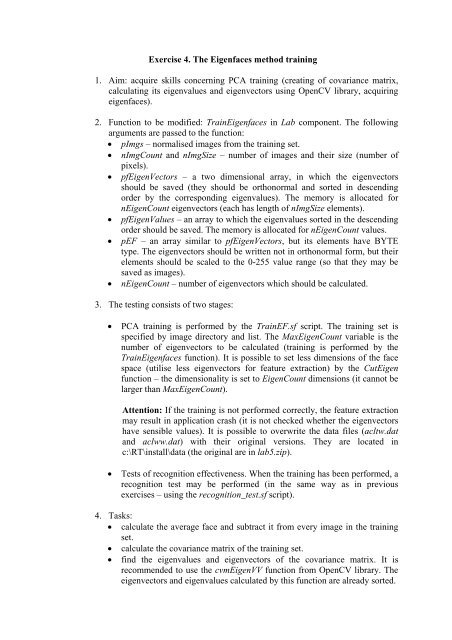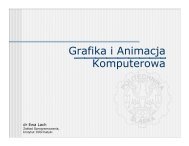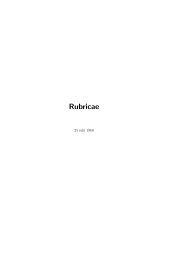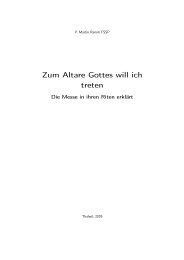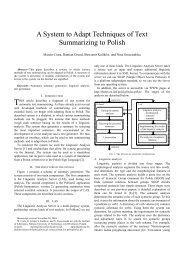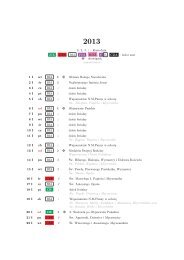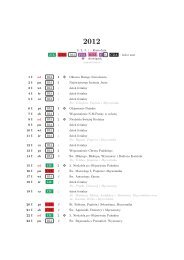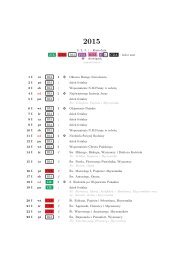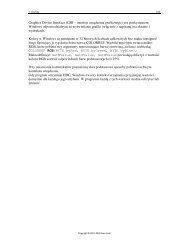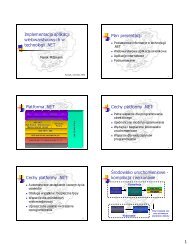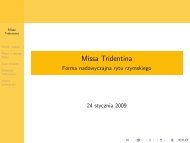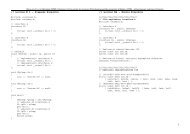Exercise 4. The Eigenfaces method training 1. Aim: acquire skills ...
Exercise 4. The Eigenfaces method training 1. Aim: acquire skills ...
Exercise 4. The Eigenfaces method training 1. Aim: acquire skills ...
You also want an ePaper? Increase the reach of your titles
YUMPU automatically turns print PDFs into web optimized ePapers that Google loves.
<strong>Exercise</strong> <strong>4.</strong> <strong>The</strong> <strong>Eigenfaces</strong> <strong>method</strong> <strong>training</strong><br />
<strong>1.</strong> <strong>Aim</strong>: <strong>acquire</strong> <strong>skills</strong> concerning PCA <strong>training</strong> (creating of covariance matrix,<br />
calculating its eigenvalues and eigenvectors using OpenCV library, acquiring<br />
eigenfaces).<br />
2. Function to be modified: Train<strong>Eigenfaces</strong> in Lab component. <strong>The</strong> following<br />
arguments are passed to the function:<br />
• pImgs – normalised images from the <strong>training</strong> set.<br />
• nImgCount and nImgSize – number of images and their size (number of<br />
pixels).<br />
• pfEigenVectors – a two dimensional array, in which the eigenvectors<br />
should be saved (they should be orthonormal and sorted in descending<br />
order by the corresponding eigenvalues). <strong>The</strong> memory is allocated for<br />
nEigenCount eigenvectors (each has length of nImgSize elements).<br />
• pfEigenValues – an array to which the eigenvalues sorted in the descending<br />
order should be saved. <strong>The</strong> memory is allocated for nEigenCount values.<br />
• pEF – an array similar to pfEigenVectors, but its elements have BYTE<br />
type. <strong>The</strong> eigenvectors should be written not in orthonormal form, but their<br />
elements should be scaled to the 0-255 value range (so that they may be<br />
saved as images).<br />
• nEigenCount – number of eigenvectors which should be calculated.<br />
3. <strong>The</strong> testing consists of two stages:<br />
• PCA <strong>training</strong> is performed by the TrainEF.sf script. <strong>The</strong> <strong>training</strong> set is<br />
specified by image directory and list. <strong>The</strong> MaxEigenCount variable is the<br />
number of eigenvectors to be calculated (<strong>training</strong> is performed by the<br />
Train<strong>Eigenfaces</strong> function). It is possible to set less dimensions of the face<br />
space (utilise less eigenvectors for feature extraction) by the CutEigen<br />
function – the dimensionality is set to EigenCount dimensions (it cannot be<br />
larger than MaxEigenCount).<br />
Attention: If the <strong>training</strong> is not performed correctly, the feature extraction<br />
may result in application crash (it is not checked whether the eigenvectors<br />
have sensible values). It is possible to overwrite the data files (acltw.dat<br />
and aclww.dat) with their original versions. <strong>The</strong>y are located in<br />
c:\RT\install\data (the original are in lab5.zip).<br />
• Tests of recognition effectiveness. When the <strong>training</strong> has been performed, a<br />
recognition test may be performed (in the same way as in previous<br />
exercises – using the recognition_test.sf script).<br />
<strong>4.</strong> Tasks:<br />
• calculate the average face and subtract it from every image in the <strong>training</strong><br />
set.<br />
• calculate the covariance matrix of the <strong>training</strong> set.<br />
• find the eigenvalues and eigenvectors of the covariance matrix. It is<br />
recommended to use the cvmEigenVV function from OpenCV library. <strong>The</strong><br />
eigenvectors and eigenvalues calculated by this function are already sorted.
• scale the calculated eigenvectors to the pixel value range and save them to<br />
pEF array. When the <strong>training</strong> is finished, the images from the array are<br />
saved automatically to c:\RT\test\eigenfaces\Eigen. <strong>The</strong> conclusions drawn<br />
from these images should be listed in the report.<br />
• perform the recognition tests for various numbers of dimensions of the face<br />
space. It is necessary to perform the <strong>training</strong> once (e.g. for 500 dimensions)<br />
and then set the dimensionality using the CutEigen function in the<br />
TrainEF.sf script. An optimal number of dimensions should be found.<br />
Perform the <strong>training</strong> for the FeretB database and the recognition tests for<br />
the FeretA database for 10, 20, ..., 200 dimensions. Draw the conclusions.<br />
5. Remarks concerning OpenCV:<br />
• there is a CvMat object which represents a matrix. It must be created using<br />
the cvCreateMat function (it returns a pointer to the new object) and<br />
deleted using the cvReleaseMat function. It is recommended to use cvmSet<br />
and cvmGet functions to access the matrix data.<br />
• the calculations should be performed for float data type (CV_MAT32F<br />
matrix type).<br />
• the precision coefficient eps should be set to 10 -3 .<br />
• some examples are presented in Lab.cpp.<br />
• more details can be found in the documentation (chapter 23, opencv.pdf<br />
file).


